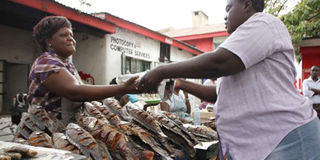Initiative to boost fish trade between Kenya and Uganda launched in Busia

Fishmonger Josephine Achieng' sells fish imported from Uganda to her client at Jubilee Market in Kisumu City on November 26, 2014. An initiative that seeks to coordinate the fish trade between Kenya and Uganda has been launched. FILE PHOTO | TONNY OMONDI | NATION MEDIA GROUP
What you need to know:
- Lake Victoria Fisheries Organisation (LVFO) executive director Oliva Mkumbo admitted that movement of fish in the region is still facing a lot of challenges across the border.
- Busia county government executive member for agriculture and fisheries Moses Osia said there is need to ensure fair trade in the region in fish trade.
An initiative that seeks to coordinate the fish trade between Kenya and Uganda has been launched.
The programme, sponsored by the two governments and the Africa Union, is expected to end frequent conflicts that have characterised the trade between the two nations.
The project is being implemented by the World Fish Trade, based in Zambia.
It is being piloted in Busia town before being rolled out to other border towns in the Common Market for Eastern and Southern Africa (Comesa) region.
“We want to facilitate [the] fish trade in the region, which has been facing several challenges. We want to see how best to put in place strategies to facilitate quick movement of fish trade between Kenya and Uganda,” said Dr Sloans Chimaro, who is the programme manager at World Fish Trade.
Dr Chimaro observed that the initiative would also ensure that standards are adhered to as it will create confidence among consumers.
He was speaking on Wednesday during a cross-border consultation forum in Busia town on the fish trade along the border.
“We are trying to develop strategies on how fish can move around the region, using Busia as a model. Fish resources are limited, every fish that is harvested must find its way to the the market and table,” he said.
Lake Victoria Fisheries Organisation (LVFO) executive director Oliva Mkumbo acknowledged that the movement of fish in the region is still facing a lot of challenges across the border.
“We want to work together and improve the fish trade. Several issues such as the customs union and the common market have done a lot in harmonisation of standards of procedures but others are still pending,” said Dr Mkumbo.
She said the LVFO has tried to ensure that the quality of fish sold in the region is up to the required standards.
“We have to ensure that the quality of the product must be improved if we hope to tap into other markets,” said the executive director.
She, however, regretted that data on the fish trade in the region is still not sufficient in determining the worthiness of the sector.
“To understand the contribution of fish products, we have to put the right information to the public so that we know the contribution of the fish trade in the GDP,” said Dr Mkumbo.
Busia County government executive member for agriculture and fisheries Moses Osia said there is a need to ensure that the fish trade in the region is fair.
“We do not require free fish trade but fair trade,” said Mr Osia, adding that illegal trade must be stopped.
He disclosed that the county government is restocking 1,500 fish ponds that had collapsed as well as training farmers on fish farming.




